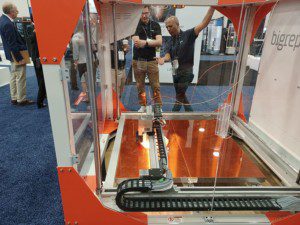Once a trade show novelty, the 3D printer has become star of the show. The additive manufacturing process was center stage Tuesday at Huntington Place in downtown Detroit for RAPID + TCT, the flagship event of Southfield-based manufacturing association SME.

Crain’s Detroit Business
Kurt Nagl
May 17, 2022
 Once a trade show novelty, the 3D printer has become star of the show.
Once a trade show novelty, the 3D printer has become star of the show.
The additive manufacturing process was center stage Tuesday at Huntington Place in downtown Detroit for RAPID + TCT, the flagship event of Southfield-based manufacturing association SME.
Hundreds of engineers and company representatives roamed the showroom floor as machines hummed along, printing everything from precision car parts to a Mandalorian helmet. Nearly 400 exhibitors signed on for the three-day event, putting a compelling picture to buzzy phrases like “Industry 4.0” and “the next industrial revolution.”
“A new era of manufacturing has arrived,” Barbara Humpton, president and CEO of Siemens USA, said during a keynote speech. “This revolution represents a convergence of our physical and virtual worlds, and what this convergence does is set the stage for additive manufacturing to remake the industrial world.”
3D printing technology, and additive manufacturing in general — a process that uses CAD software or 3D object scanners to direct hardware to deposit material, layer upon layer, in precise shapes to create an object — has evolved by leaps and bounds in the past few years from prototypes and toys printed at a snail’s pace to speedy production of parts in a wide array of products as mundane as coffee makers and as cutting edge as SpaceX rockets.
The global 3D printing market reached a value of $17.54 billion in 2020 and is projected to hit $79.4 billion by 2028, according to market researcher Reports and Data, which is based in India with an office in New York City.
The technology has not yet reached mainstream manufacturing, largely due to high costs of adoption, but there are plans afoot to change that.
For example, Automation Alley’s Project Diamond has invested $10 million since 2020 in 3D printers for 244 local manufacturers, creating one of the largest 3D printing networks in the U.S. The project was launched to produce personal protective equipment (PPE) during the onset of the coronavirus pandemic but has since been used to produce parts amid supply shortages.
“… It has transitioned into a tool for these manufacturers to improve and increase the production of badly needed parts in an era of supply chain disruptions and shortages,” Oakland County Executive David Coulter said in a news release last week.
Besides developing technology and ramping up speed to market, one area of focus for the industry has been diversification. Kicking off the conference, SME announced a new partnership with Women in 3D Printing in hopes of closing the gender gap in additive manufacturing.
The organizations will join forces to produce future conferences, launch a mentorship program and co-author an annual report measuring diversity, equity and inclusion in the industry, according to a news release.
Women in 3D Manufacturing is a nonprofit registered in California with more than 80 chapters across 36 countries.
“It is important that the Additive Manufacturing industry is reflective of the real world, and we want to send a clear message that it is for everyone,” Nora Toure, founder of the nonprofit, said in the release.
View the original article.
